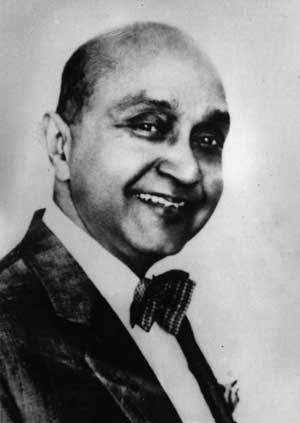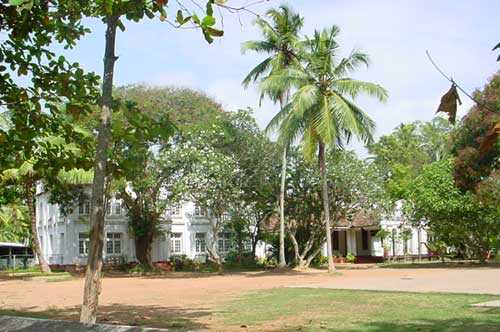
Kalutaravedage Deepal Susantha de Fonseka was born at the turn of the century (1900) in Panadura. He was a grandson of the legendary Sri Chandrasekera of Panadura. His father Dr C. P. De Fonseka married Muthutantrige Leonora Fernando Sri Chandrasekara a daughter of Muthuthanthrige Simon Fernando Sri Chandrasekera, one of the largest purchasers of crown land in the later part of the 19th century (1). He was also the son-in-law of another legendary entrepreneur, Mathes Salgado, arrack renter and founder of a chain of bakeries (2). He married Mathes Salgado’s daughter, Jane Misina (Gertie) Salgado.
Susantha had his early education at the Colombo Academy (Royal College) and went on to England for his higher education. He studies at the Downing College in Cambridge in the early 1920’s. Among his Ceylonese contemporaries at Cambridge were Paul Pieris Jnr., George R. De Silva, S. Saravanamuttu and Devar Surva Sena (3). After receiving his master’s degree from Cambridge University, he entered the Inns of Court and qualified as a barrister.
On his return, Arthur de Silva his uncle, who was then in the vanguard of Buddhist education, got him his first job at Sri Sumangala College, Panadura, and then in the leading nationalist English daily of the time, the ‘Morning Leader’. It was after the era of the great Armand D’Souza that Susantha de Fonseka sat in the editorial chair of that newspaper.
Susantha De Fonseka entered the world of politics with the elections for the 1931 State Council. He was elected to the 1931 State Council (as member for Panadura) together with John L Kotelawela, Henry W Amerasuriya and S.W.R.D Bandaranayaka (2). He was reelected again in the 1936 general election.
Susantha took an active part in the in the country’s struggle for universal suffrage and self-determination. First it was with the Donoughmore Commission who had come to Ceylon to determine what its constitution should be. In later years it was with the Soulbury commissioners (1943 – 1945). Susantha de Fonseka as the State Council member for Panadura, moved a motion in the State Council, by November 1944, to the effect that the Ministers “be directed to introduce immediately a Bill conferring on this country a constitution of the recognized dominion type for Free Lanka” (4).
While holding the post of Deputy Speaker, Susantha de Fonseka also did a stint of duty in the armed forces as a commissioned officer in the Naval Volunteer Force. These were the formative years for a truly Ceylonese force. In January 1938, he was one of the first Ceylonese to be commissioned into the Sri Lanka Navy as officers (5).
Hon. Susantha De Fonseka resigned from the State Council after challenging the then powerful colonial government of controlling the rubber purchase prices. This also cost him his commission with the Ceylon Navy.
But he was not to remain in the political wilderness for long. With Ceylon gaining independence in 1948, he was appointed as Sri Lanka’s first Ambassador to Burma in 1949. He excelled in his new job in Rangoon that soon he won the confidence and regard of the then Prime Minister of Burma, U Nu. He studied the Burmese language so fast that other diplomats were amazed at his capacity to make impromptu speeches in that language. Anthony de Fonseka, a family member who assisted him in his early political work, still fondly remembers Sir Susantha attending the wedding of his uncle, dressed in full Burmese Suit and headgear.
Struck by the abilities of Colombo’s man in Rangoon, D. S. Senanayake sent him on an important diplomatic assignment to Peking in 1952. It was this assignment, which laid the foundation for the rubber-rice pact with China (6).
After the general elections of 1952, when the price of rubber declined in the international market, Dudley Senanayake, the new premier, was suddenly saddled with a stagnant economy. Following the end of the World War II in 1945, the price of rubber dropped to Rs 1 per pound. With the impact of synthetic rubber, the price dropped further to a low of 46 cents per pound. During the Korean War, the price began to pick up with the entry of China into the war. Ceylon sold a large quantity of rubber to China.
Ceylon took a bold step by entering into a rubber-rice barter agreement with China. Ceylon was to get six tons of rice for every ton of rubber exported to China, which was double the current market price in those days.
At the time Ceylon had not established diplomatic ties with China, so the ambassadors of China and Ceylon based in Burma negotiated the barter agreement. As a follow-up, the Ceylon government sent a trade delegation to China in September 1952. It was led by R G Senanayake and left on September 14. The minister clinched the deal on behalf of Ceylon and on October 4 a provisional rubber-rice agreement was signed. After initial hesitancy and opposition, a second mission left for Peking, led by Susantha de Fonseka, Ceylon’s Ambassador in Burma, on November 23, and a pact was signed on December 18. The agreement came into force on January 1, 1953 and Ceylon benefited immensely for years from the agreement.
After the Burmese posting, Sir Susantha de Fonseka, began the Ceylon Mission in Japan in 1952. Just as in Burma, Sir Susantha fell in love with the country and it’s people. It was not long before he mastered the Japanese Language and learned to speak fluent Japanese. He also actively took part in Buddhist activities bridging the countries together.
Susantha de Fonseka was appointed a Knight Bachelor (K.B.E) on the 12th of April 1954.
The Order is used to reward services to the State, defined to acknowledge distinguished service to the arts and sciences, public services outside the Civil Service and work with charitable and welfare organizations of all kinds. Valuable service is the only criterion for the award. The Queen, or the member of the Royal family holding the Investiture, remains standing throughout the one-hour ceremony. After the National Anthem has been played either the Lord Chamberlain or the Lord Steward announces the name of each recipient and the achievement for which he or she is being honoured. The Queen then places the decoration on the person concerned before congratulating them on receiving the award. Those who are to receive a knighthood (and who are therefore entitled to style themselves ‘Sir’), kneel on an Investiture stool before the Queen. The Queen uses the Scots Guards sword used by her father, King George VI, to dub the recipient.
Many still believe that at this point, the Queen utters the magic words ‘Arise Sir ….’, which leads to the caption in this article. However information gleaned from the Royal website on the investiture ceremony and other sources indicate otherwise. “Contrary to popular belief, the Queen does not use the form ‘Arise, Sir …’, but touches the kneeling knight lightly on each shoulder with the flat sword.”
 Sir Susantha de Fonseka died in the year 1963. Among the many tributes in his memory are the Sir Susantha De Fonseka memorial Prize for Arts at Royal College. The road, which ran by his palatial house named ‘Siri Medura’, has been named ‘Susantha Mawatha’ in memory of him. You will find this road crossing the new Galle Road at Panadura, close to the Post Office complex. If you are traveling towards Galle, turn right towards the old road and the lagoon. His house is found near the end where it meets the old road (now called Arthur V. Dias Mawatha) facing the beautiful Panadura lagoon. Pictured below is the premise, as used by an International School at that time.
Sir Susantha de Fonseka died in the year 1963. Among the many tributes in his memory are the Sir Susantha De Fonseka memorial Prize for Arts at Royal College. The road, which ran by his palatial house named ‘Siri Medura’, has been named ‘Susantha Mawatha’ in memory of him. You will find this road crossing the new Galle Road at Panadura, close to the Post Office complex. If you are traveling towards Galle, turn right towards the old road and the lagoon. His house is found near the end where it meets the old road (now called Arthur V. Dias Mawatha) facing the beautiful Panadura lagoon. Pictured below is the premise, as used by an International School at that time.
Update 2018:
The palatial house built by Susantha de Fonseka has been sold, and is no longer within the family. The following article published in The Sunday Times newspaper (reproducing the photograph seen on your right) referencing this transaction has been reproduced below. The link to the original article has also been included and may function within time limits.
Article:
Monks and residents of Panadura protest demolition of historic bungalow.
Reference:
(1) Caste Conflict and Elite Formation – Michael Roberts.
(2) Nobodies to Somebodies – Kumari Jayawardene.
(3) “Of Sri Lanka I Sing” – The Life & Times of Devar Surva Sena, 1978.
(4) Sri Lanka: The Untold Story, Chapter 10:
Lord Soulbury and his soulless report By K T Rajasingham
(5) Sri Lanka Navy Website.
(6) Sri Lanka: The Untold Story, Chapter 15:
Turbulence in any language By K T Rajasingham
(7) Family Tree of Sir Deepal Susantha de Fonseka.
